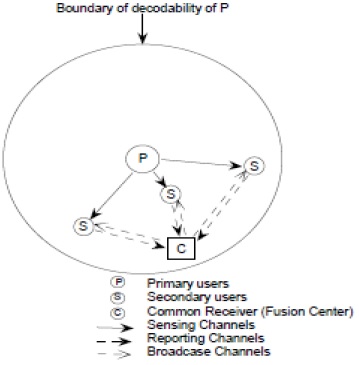Primary Sensor Detection for Primary Tradeoff Cognitive Radio Network
DOI:
https://doi.org/10.54741/asejar.2.5.4Keywords:
spectrum, sensor, clusterAbstract
Cognitive radio (CR) has been recently proposed as a promising technology to improve spectrum utilization by enabling secondary access to unused licensed bands. A prerequisite to this secondary access is having no interference to the primary system. This requirement makes spectrum sensing a key function in cognitive radio systems. Among common spectrum sensing techniques, energy detection is an engaging method due to its simplicity and efficiency.
The growing demand of wireless applications has put a lot of constraints on the usage of available radio spectrum which is limited and precious resource. Cognitive radio is a promising technology which provides a novel way to improve utilization efficiency of available electromagnetic spectrum. In this paper, a cluster-based optimal selective CSS scheme is proposed for reducing reporting time and bandwidth while maintaining a certain level of sensing performance. Clusters are organized based on the identification of primary signal to-noise ratio value, and the cluster head in each cluster is dynamically chosen according to the sensing data qualities of CR users.
The cluster sensing decision is made based on an optimal threshold for selective CSS which minimizes the probability of sensing error. A parallel reporting mechanism based on frequency division is proposed to considerably reduce the time for reporting decision to fusion center of clusters. In the fusion center, the optimal Chair-Vashney rule is utilized to obtain a high sensing performance based on the available cluster’s information.
Downloads
References
J. Mitola, & G. Q. Maguire. (1999). Cognitive radio: Making software radios more personal. IEEE Pers. Commun., 6, pp. 13–18.
I. Akyildiz, W. Lee, M. Vuran, & S. Mohanty. (2006). NeXt generation/dynamic spectrum access/cognitive radio wireless networks: a survey. Computer Networks, 50(13), 2127–2159.
L De Nardis, D Domenicali, & MG Di Benedetto. (2009). Clustered hybrid energy-awarecooperative spectrum sensing (CHESS), in: 4th International Conference on Cognitive Radio Oriented Wireless Networks and Communications 2009 (CROWNCOM ’09), pp. 1–6
L Chen, J Wang, & S Li. (2007). An adaptive cooperative spectrum sensingscheme based on the optimal data fusion rule. 4th International Symposium on Wireless Communication Systems, spp. 582-586.
L Hesham, A Sultan, M Nafie, & F Digham. (2012). Distributed spectrum sensing with sequential ordered transmissions to a cognitive fusion center. IEEE Trans. Signal Process, 60, 2524–2538.
SMaleki, & G Leus. (2013). Censored truncated sequential spectrum sensing for cognitive radio networks. IEEE J Selected Areas Commun, 31, 364–378.
B Vo Nguyen Quoc, TQ Duong, D Benevides da Costa, GC Alexandropoulos, & A Nallanathan. (2013). Cognitive amplify-and-forward relaying with best relay selection in non-identical Rayleigh fading. IEEE Coml., 17(3), 475–478.
C Sun, W Zhang, & KB Letaief. (2007). Cluster-based cooperative spectrumsensing for cognitive radio systems. Proceedings of IEEE International Conference on Communications, Glasgow, pp. 2511–2515
G. Ganesan, & Y. G. Li. (2005). Agility improvement through cooperative diversity in cognitive radio. In: Proc. IEEE GLOBECOM’05, pp. 2505–2509.
A. Ghasemi, & E. Sousa. (2005). Collaborative spectrum sensing for opportunistic access in fading environments. In: Proc. IEEE DySPAN’05, pp. 131–136.
E. Peh, & Y.-C. Liang. (2007). Optimization for cooperative sensing in cognitive radio networks. In: Proc. IEEE WCNC’07, pp. 27–32.
J. Unnikrishnan, & V. V. Veeravalli. (2008). Cooperative sensing for primary detection in cognitive radio. IEEE J. Sel. Topics Signal Proc., 2(1), pp. 18–27.
Z. Quan, S. Cui, & A. H. Sayed. (2008). Optimal linear cooperation for spectrum sensing in cognitive radio networks. IEEE J. Sel. Topics Signal Proc., 2(1), pp. 28–40.
Y.-C. Liang, Y. Zeng, E. Peh, & A. T. Hoang. (2008). Sensing-throughput tradeoff for cognitive radio networks. IEEE Trans. Wireless Commun., 7(4), pp. 1326–1337.
HUrkowitz. (1967). Energy detection of unknown deterministic signals. Proc. IEEE, 55(4), pp. 523–531.

Downloads
Published
How to Cite
Issue
Section
ARK
License
Copyright (c) 2023 Saka Sogbochi, Elie Sohounhloue

This work is licensed under a Creative Commons Attribution 4.0 International License.
Research Articles in 'Applied Science and Engineering Journal for Advanced Research' are Open Access articles published under the Creative Commons CC BY License Creative Commons Attribution 4.0 International License http://creativecommons.org/licenses/by/4.0/. This license allows you to share – copy and redistribute the material in any medium or format. Adapt – remix, transform, and build upon the material for any purpose, even commercially.










